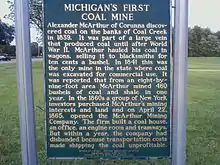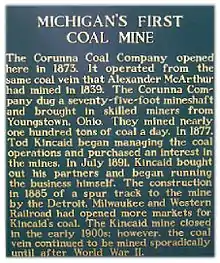McArthur Mining Company
The McArthur Mining Company (a.k.a. Corunna Coal Company) is a defunct coal mining company. It was Michigan's first coal mine, with the first coal mined in 1839.[1][2][3][4]

Beginning history
The beginnings of the McArthur Mining Company were in 1836. Alexander McArthur occupied at that time the only log house in Shiawassee County along the Shiawassee River in Caledonia Township in section 22. A geological survey was done that same year for the State of Michigan. Douglass Houghton was placed in charge of it. Corunna and Caledonia Township, in Shiawassee County were visited during the progress of the state survey. The examination of sections 22 and 23 of Caledonia Township made at the time along the Shiawassee River indicated the presence of coal, shale, and fire clay; but none were actually discovered then.[5]
In 1839 McArthur discovered coal on his land near a clearing where Indians dug clay for their pottery on the bank of what was to be called Coal Creek, a stream that fed into Shiawassee River. McArthur first took out small quantities of coal for his own use. Later he sold the coal mostly to blacksmiths, who came from considerable distances to obtain it because of its quality. The veins he found were rich in high quality coal and it was even reported that from an 8-foot x 9 foot vein McArthur mined 460 bushels of coal and shale in one year. Even in 1841 this was the only mine in Michigan from which coal was excavated for commercial use. His coal-selling business was successful and increased tremendously in a short time. He then delivered his coal in wagons pulled by horses, selling it for ten cents a bushel.[6][7]
Mid-life history
McArthur obtained in 1864 the assistance of B. Brisco, master mechanic of the Detroit and Milwaukee Railroad, in making investigations of his coal deposits to determine its value for mining. There were certain investors from New York City who became interested in the results of the reports of McArthur's coal. It was decided then to officially make a company for the purpose of mining that coal. Funds of $100,000 were raised. McArthur sold then to the investors on April 22, 1865, to the new-born company a plot of land consisting of 120 acres on the east half of the northwest quarter and the west half of the west part of the northeast quarter of section 22. The new company was called McArthur's Mining Company.[5]
The investors in McArthur's Mining Company, besides Alexander McArthur, were Dr. G. M. Peck, Samuel Daskham, and Edward W. Lockwood of New York City. Dr. Peck was chosen president and Alexander McArthur as local agent. The new company erected an engine–room, a coalhouse, an office, and tramways. Their initial investment was also used for machinery and other buildings at the mines. They also constructed a very large wharf on the Detroit River where the coal was taken to. From Detroit the coal was carried by steamers to New York City. The cost of transportation of the coal was more than anticipated and soon it became unprofitable to operate the company. The company was dissolved a year after it started.[2]
Briar Hill Iron and Coal Company of Ohio in 1869 through 1870 sent out their representative Charles Gilbert, a practical geologist, to examine the coal region around Corunna, Michigan and the area at McArthur's Mining Company. He began testing for coal by drilling test-holes. Gilbert drilled 56 test-holes of which 46 showed coal deposits in section 23 of Caledonia Township. Henry P. Gilbert purchased from Chauncey Hurlburt on April 1, 1871, some 66 acres of land where these tests were made. He in turn sold an interest in this land in December of that year to other investors, George F. Perkins, John Stambaugh, of Akron, Ohio, and George Todd, of Youngstown, Ohio. The investors opened a slope and to mine coal in 1872. They invested over $90,000 to make the venture profitable, but within a year they went broke. An improvement that this company left behind was a railroad track from the mine to the Corunna Depot. This was a major improvement over horse–drawn and ox–drawn wagons that had been used for some 38 years before.[7]
Final history

side 2
The Corunna Coal Company was then organized for mining coal, fire clay, and other ores on February 26, 1873. They mined from the same vein where mining was started by Alexander McArthur back in 1839. The investors were working with $150,000 for this venture. They were George F. Perkins, of Akron, Ohio; George Todd, of Youngstown, Ohio; and Henry P. Gilbert, Harry R. Gilbert, Thomas Struthers, and John Stambaugh - all of Ohio. The officers were George Todd, President; and Todd Kincaid, Secretary and Treasurer. This new 1873 company had offices both at Youngstown, Ohio, and Corunna, Michigan.[7]
The lands previously worked on section 23 by the Briar Hill Iron and Coal Company were purchased by the Corunna Coal Company on December 5, 1874. They were already leasing the lands. Corunna Coal Company did a thorough investigation on the properties they owned and determined that there was large deposits of coal deep in the earth. In 1877 they then opened a new shaft 75 feet in length. They hit a rich vein of coal. It was two feet three inches to three feet nine inches in thickness.[7]
The company then set up operations to mine and ship it and had it fully operational by June 1877. Local workmen were not skilled in this industry, so the company hired about 100 coal workmen from Ohio of which 75 were skilled miners. In the winter months 75 to 100 tons of coal were mined daily. The summer months resulted in less production. Transportation of the coal went about 2.5 miles from the mines to the depot of the Detroit and Milwaukee Railroad, a fairly difficult task. This task became easier when a branch road from Corunna was built.[7]
Tod Kincaid, Secretary and Treasurer, purchased an interest in the mines in 1877. By 1891 Kincaid bought out his partners and became the general manager. A spur track to the mine by the Detroit, Milwaukee and Western Railroad was constructed in 1885. The Kincaid Mine officially closed in the early 1900s; however, the coal vein continued to be mined from time to time until shortly after World War II.[8]
References

- Argus-Press Oct 5, 1988 p. 8 Historical Marker to denote site of First State Coal Mine
- Argus-Press Oct 12, 1988 p. 18 "First Coal Mine" Historical Marker Dedication held
- Argus-Press Jul 2, 2001, p. 2 Remembering Caledonia Township's coal mine
- PINE TREE CEMETERY - History & Historical Figures McArthur discovered coal in the area in 1839 and established Michigan’s first coal mine.
- Past and Present Shiawassee County, Michigan , pp. 126-127
- Ashlee, p. 412
- Ellis, p. 218
- Argus-Press Jul 2, 1976 p. 22 "Iron Horse Hits Corunna"
Sources
- Ashlee, Laura Rose, Traveling Through Time: A Guide to Michigan's Historical Markers , University of Michigan Press, 2005, ISBN 0-472-03066-3
- Ellis, Franklin, History of Shiawassee and Clinton counties, Michigan , D.W. Ensign & Company, 1880
- Past and Present Shiawassee County, Michigan Shiawassee County Historical Society, 1906
